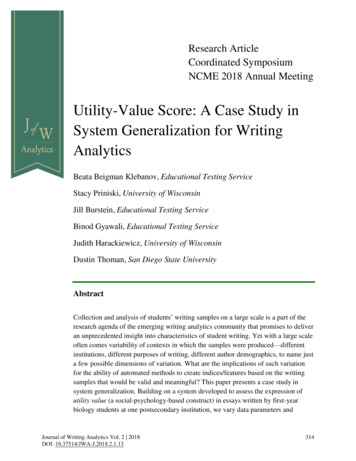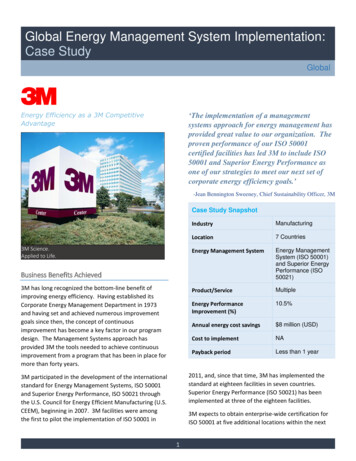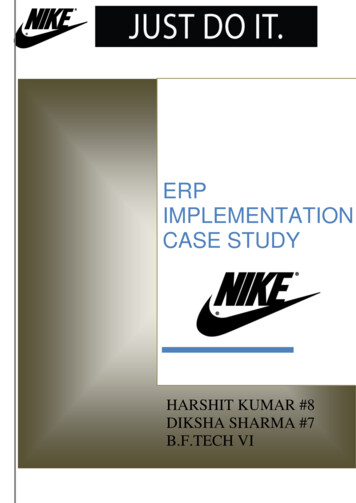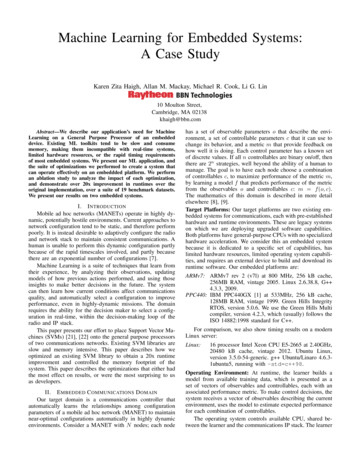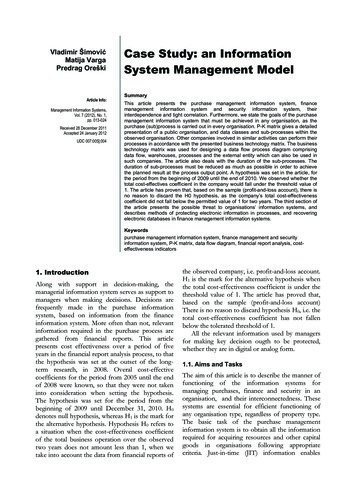
Transcription
Vladimir ŠimovićMatija VargaPredrag OreškiArticle Info:Management Information Systems,Vol. 7 (2012), No. 1,pp. 013-024Received 28 December 2011Accepted 24 January 2012UDC 007:005]:004Case Study: an InformationSystem Management ModelSummaryThis article presents the purchase management information system, financemanagement information system and security information system, theirinterdependence and tight correlation. Furthermore, we state the goals of the purchasemanagement information system that must be achieved in any organisation, as thepurchase (sub)process is carried out in every organisation. P-K matrix gives a detailedpresentation of a public organisation, and data classes and sub-processes within theobserved organisation. Other companies involved in similar activities can perform theirprocesses in accordance with the presented business technology matrix. The businesstechnology matrix was used for designing a data flow process diagram comprisingdata flow, warehouses, processes and the external entity which can also be used insuch companies. The article also deals with the duration of the sub-processes. Theduration of sub-processes must be reduced as much as possible in order to achievethe planned result at the process output point. A hypothesis was set in the article, forthe period from the beginning of 2009 until the end of 2010. We observed whether thetotal cost-effectives coefficient in the company would fall under the threshold value of1. The article has proven that, based on the sample (profit-and-loss account), there isno reason to discard the H0 hypothesis, as the company’s total cost-effectivenesscoefficient did not fall below the permitted value of 1 for two years. The third section ofthe article presents the possible threat to organisations’ information systems, anddescribes methods of protecting electronic information in processes, and recoveringelectronic databases in finance management information systems.Keywordspurchase management information system, finance management and securityinformation system, P-K matrix, data flow diagram, financial report analysis, costeffectiveness indicators1. IntroductionAlong with support in decision-making, themanagerial information system serves as support tomanagers when making decisions. Decisions arefrequently made in the purchase informationsystem, based on information from the financeinformation system. More often than not, relevantinformation required in the purchase process aregathered from financial reports. This articlepresents cost effectiveness over a period of fiveyears in the financial report analysis process, to thatthe hypothesis was set at the outset of the longterm research, in 2008. Overal cost-effectivecoefficients for the period from 2005 until the endof 2008 were known, so that they were not takeninto consideration when setting the hypothesis.The hypothesis was set for the period from thebeginning of 2009 until December 31, 2010. H0denotes null hypothesis, whereas H1 is the mark forthe alternative hypothesis. Hypothesis H0 refers toa situation when the cost-effectiveness coefficientof the total business operation over the observedtwo years does not amount less than 1, when wetake into account the data from financial reports ofthe observed company, i.e. profit-and-loss account.H1 is the mark for the alternative hypothesis whenthe total cost-effectiveness coefficient is under thethreshold value of 1. The article has proved that,based on the sample (profit-and-loss account)There is no reason to discard hypothesis H0, i.e. thetotal cost-effectiveness coefficient has not fallenbelow the tolerated threshold of 1.All the relevant information used by managersfor making key decision ougth to be protected,whether they are in digital or analog form.1.1. Aims and TasksThe aim of this article is to describe the manner offunctioning of the information systems formanaging purchases, finance and security in anorganisation, and their interconnectedness. Thesesystems are essential for efficient functioning ofany organisation type, regardless of property type.The basic task of the purchase managementinformation system is to obtain all the informationrequired for acquiring resources and other capitalgoods in organisations following appropriatecriteria. Just-in-time (JIT) information enables
Vladimir Šimović, Matija Varga, Predrag Oreškigenerating profit within purchase sub-processes.The additional tasks of the acquisition processinclude cost-cutting when purchasing resourcesand capital goods, thus enabling efficient operationof the entire system. The article demonstratedpossible threats to the organisation’s informationsystems, ways of protecting the information andretrieval of electronic data in the financemanagement information system. Within thefinance management information system, thearticle will demonstrate a decision making supportsystem, and indicators for measuring the progressflow in the information management informationsystem. These three information system were takeninto consideration due to the fact that are highlysignificant for overall management andadministration, and because the purchasemanagement is of key importance for seamlessprocess flow in organisations. The informationsystem is essential for recording events andchanges in business, and analysing financial reports.The security management information system takescare of he protection of relevant and reliableinformation, and protection of electronicinformation of importance for the organisation.1.2. Employed Research MethodsThe research methods employed here inlude: casestudy, modelling (data flow diagram and businesstechnology matrix), interview, measurement(determining the exact time), statistical methods(indexes), observation, perception, analysis(content analysis, business system analysis andother indicator system), which will be used fordetermining business objects, processes, events,information, documents and information systemprotection measures.2. Purchase Management InformationSystem and its SignificanceIt is a well-known fact that an information systemis a data image of processes from objective reality.The aim of any information system is to providethe system with all necessary and relevantinformation for seamless execution of processesand system administration. Purchase managementinformation system is a complicated systemenabling communication of the company with itsbuyers and suppliers, keeping track of capital goodsflow, all condition for monitoring businessrelationships, preparing and transferring data intothe finance management information system, moreprecisely, into process accountancy. (Panian &14Management Information SystemsVol. 7, 1/2012, pp. 013-024Ćurko, 2010, p. 93) One cannot dispute the thesisthat the purchase management system is the mostimportant. It is used for gathering informationrequired for seamless performance of all processesin organisations.Figure 1 Connections between information systems andtheir parts(Varga et al., 2007 based on condsiderations on connections between thepresented information systems)The purchase process and its sub-processes areused for purchasing or commissioning information,commodities, other capital goods, services andlabour. One cannot dispute Vilim Ferišak’s (2006)thesis that profit is generated in purchase.Purchasing better capital goods at prices lower thanthear real value generates profit, and cuts purchasecosts.This is another piece of evidence that thepurchase and finance management systems areclosely connected (Figure 1). Finance managementinformation system is also very important, as itrecords all business events occurring in theorganisation, and takes care of the availability offunds. Security management information systemcannot function without finance managementinformation system out of which it is financed, norcan the information management system functionwithout security management information systemwhich protects it constantly. Figure 1 shows theinterconnectedness of the above mentionedinformation systems and parts of the segments ofinformation system (program segment, hardware)segment, organisation segment, human resourcesegment, network and data segments required forseamless operation of business processes.2.1. Purchase Management InformationSystem DecompositionPurchase management information systemdecomposition is segmenting the system toinformation subsystems according to a definedorder and in an appropriate manner, observing the
Case Study: an Information Syystem Managemment Modeldecomposition rule, statingg that each parentpmusthaveha minimum of two offffsprings.The purchasing processpbegins fromestablishing the need to puurchase capitaal goods.2.3. Purposse and Taskss of PurchaseManagement Informatioon SystemFigure 2 Decoomposed aims oof the purchase managementminformationn syste,(The author’s oown design)he goals ofFirgure 2 illustrated deecomposing ththe purchase management information system.sThegoalsgpresentted here connmprise their own subgoals,gwhich is obvious frrom the graphhic models:gatherginformmation on purrchase conditiions; gatherinformationio the best suuplier; gather informationonon the possiible cuts in purchase coosts; gatherinformationio storage coonosts; gather informationon handling costccuts; to rresearch the marketmandgathergfield datadbased onn an appropriaate sample;gatherginformmation on the optimum order quality;gatherginforrmation on delivery termstandconditions; tot gather innformation ono trainingrequirementsrfor purchasing staff; andagatherinformationio the purchasse risk levels.on2.2.2 Purchasse StrategyPurchasePstattegy forms a plan set in suchsa waythat it will enaable the organnisation to acccomplish itsset goals. PurchasePis an executivve processconsisting off numerous aactivities. Thee purchasestrategy shoould be incorporated in theorganisation’ss overall businness strategy. Purchasingcan be regarrded as an organisation’s subsystem,and its activvities can maake an impacct on costcutting and performancee improvent. For thepurchasepprossess to functioon well, it is neecessary to:1. establish good relatioonships withh businesspartners products are puurchased fromm,2.2 avoid depeendence on a single seller,3. upskill thhe purchase department staff: andmotivate thet staff.The purposee of the purcchase managemment systemis to achievee the set goals related to suupplying theorganisationn it belongs tot with all caapital goods,services, eneergy and labouur. In this theyy must makesure to obtaiin a sufficientt amount of capital goods,at the mostt reasonable prices possibble, with ontime.in-full- right-place delivery, from reliableho fulfill theirr abilities onsources, i.e. suppliers whonscientiously,, and providee appropriatetime and copre-sale andd aftersale servvice. In the caase of publicprocurement, it is necesary to pay atteention to thesuppliers buusiness abilties, which is prooven throughfinancial repports and refferences. The purpose ofthe purchaasing process is to coonnect andharmonise the organisaation’s requirrements forcapital goodds, services, laabour and ennergy on theone hand, andathe interrests of the suppliers ofthose commmodieties on thhe other.2.3.1. Internall and External DocumentDFloww in theInformation, PurchasePand Innformation SysstemsThe business technology matrix is a strrictly defined2D1 mathemmatical struccutre, subjectt to formalmathematicaal operationss such as verifyingvtheconsistency of businesss technology or systemn, and describbes reslationshhips betweenoptimisationvarious factors. (Brumec, 2007) The matrix is sostructured thhat there is noo process solelly generatingdata classes,, without usinng any of them. The P-Kmatrix is thhe mathemattical presentaation of thenumber of processes,psubb-processes, activitiesaanddata classes. A process is a set of activvities flowingin a given order.oA data class is a logiically shapedand conneddted data set, related to a givenphenomenonn or entity. The businesss technologymatrix for the supply managementmw partiallywasm. P-k matrisused for creating the dataa flow diagramis more appropriate for presennting largeinformation systems, duee to clearer reepresentationof relationshhips, and deteermining which process orsub-process creates, reaads, updates and deletesstrictly deterrmined data cllasses.12D denotes twwo demensions: (1) data classes anda (2) numberand names of processes.pManaagement Informaation SystemsVol. 7, 1/2012, pp. 013-02415
Vladimir Šimović, Matija Varga, Predrag OreškiFigure 3 The P-K matrix(The author’s design, based on the business logic of the observed company, and established 20 sub-processes and 50 data classes with analyticaldata processing tools.)Figure 3 shows a detail picture of theinformation system of a public organisation,divided into parts or subsystems, and itsfunctioning. The business technology matrix offers16Management Information SystemsVol. 7, 1/2012, pp. 013-024data on the purchase management informationsystem, and all documents required to the purchasedepartment for seamless process flow. Figure 3shows determined processes and data classes inaccordance of phases of public procurement of
Case Study: an Information System Management Modelgoods, labour and labour for the purchasemanagement information system, and otherinformation systems tightly connected to it, andcollaborating on task performance. As purchasemanagement information system is tightlyconnected with other information systems withinthe organisation, Figure 3 shows a more complexbusiness technology matrix. A business technologymatrix shows which documents, as data carriers,are required by the purchase managementinformation system so that the suppliers can assurepurchasing organisation’s management that theycan achiever the set goals and perform the workindependently. When taking over the materials andcapital goods within the purchase process, it isnecessary to establish the state of the suppliedproduct and control
Case Study: an Information System Management Model Vladimir Šimović Matija Varga Predrag Oreški Article Info: Management Information Systems, Vol. 7 (2012), No. 1, pp. 013-024 Received 28 December 2011 Accepted 24 January 2012 UDC 007:005]:004 Summary This article presents the purchase management information system, finance
